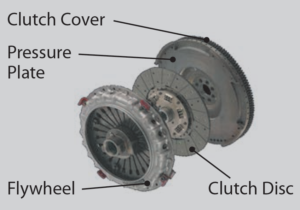The clutch is located between the engine and transmission (T/M), and is responsible for transmitting the force produced by the engine to the transmission during take-off and driving (Fig. 1-1), as well as cutting off the engine’s output when stopping the vehicle or changing gears (Fig. 1-2).

<Remarks>
Transmissions are either manual or automatic, with the former coupled with dry clutches, and the latter with wet clutches. This document describes dry clutches for manual transmissions.

Manual transmission

Automatic transmission
2. Construction

Flywheel – This smooths out the engine’s rotation.
Clutch disc – This is pressed against the flywheel to transmit the engine’s power to the input shaft.
Pressure Plate – This presses the clutch disc against the flywheel to transmit the engine’s power.
Diaphragm spring – This moves the pressure plate inside the clutch cover.
Clutch cover – This manipulates the pressure plate and presses it against the clutch disk.
Release shaft/Release bearing – This controls the pressure plate.
3. Types of clutch discs
1)Clutches come in two types based on the material they are made of.
Type
Image
Characteristics
Molded disc

This type of disc produces less shock when the clutch engages. This means that this type has relatively fewer adverse effects on the drive train, and there is no need to replace the clutch cover or flywheel when replacing the disc.
This type of disc enables a greater half-clutching range, making it easier to operate the vehicle with the clutch not fully engaged. The outer edge of the disc is lightweight, producing less inertial moment and improves clutch response at high engine revolutions.
Metal disc

Metal material is durable and therefore offers longer life cycle. Metal material offers good temperature characteristics with greater resistance to fading, which means that there are fewer adverse effects on performance caused by high temperatures, and less slippage even when the clutch is used extensively in the half-clutch state.
2) Clutches come in two types based on how many discs they use.
Type
Image
Characteristics
Single-plate type

This refers to clutches that use a single clutch disc between the flywheel and pressure plate. These types of clutches have a simple construction, are lightweight, do not require large movements of the pressure plate, offer good clutch response, and allow quicker gear shifting.
The majority of Hino manual transmission vehicles currently use this type of clutch.
Dual-plate type

This refers to clutches that use two clutch discs between the flywheel and pressure plate. These types of clutches are able to transmit greater torques, and have smaller disc circumferences and consequently smaller inertial moments, which means they require less shifting force and pedaling force.
These types of clutches are currently not used on many Hino vehicles.
4. Types of clutch covers
Clutch covers broadly come in two types based on pressure plate movement.
Type
Image
Characteristics
Coil spring clutch cover

Provides uniform pressure plate pressing force.
Diaphragm spring clutch cover

Uses fewer parts, making for a lighter clutch cover.
5. Differences between genuine and aftermarket parts
- Hino genuine clutches
- In contrast to aftermarket parts that focus on generic compatibility, Hino genuine clutches have been designed specifically to be compatible with Hino vehicles.
- These clutches offer better performance and quality than those of aftermarket parts that focus on generic compatibility.
- These clutches offer excellent resistance to wear, which results in less frequent replacements and lower costs.
- Differences between genuine and aftermarket parts
Item
Genuine
Aftermarket parts
1. Life cycle
Life cycle is one year or longer
Half (or less than half) of the life cycle of genuine parts
2. Take off characteristics
Smooth torque transmission results in smooth take off.
Torque transmission is not smooth which results in juddering.
3. Heat resistance (Heating during half clutching)
The clutches have appropriate wear coefficients.
The facing is prone to heating more during half-clutching, which leads to a poorer wear coefficient.
4. Damper performance
Delivers excellent sonic-vibration performance when idling and driving.
Poor sonic-vibration performance leads to noise and vibration.
The performance data of aftermarket parts shown above were obtained from a limited sampling of parts and do not represent the performance of all aftermarket parts.
6. The importance of periodic inspections and maintenance
1) Usage beyond limit
Using the clutch disc or clutch cover beyond their usage limits can cause your vehicle to become immobile, resulting in extra costs for towing, etc.

2) Phenomena and action
If you notice any of the following, it is time to replace your parts. We recommend early replacement
Phenomena
Cause
Actions
Slippage
- Your vehicle does not accelerate even as the engine revs up.
- Your vehicle does not have the hill climbing performance that it used to.
- Oil on disc surface
- Disc surface is worn.
- Pressure plate is warped.
- Replace clutch disc
- Replace pressure plate
Jittering
- Your vehicle’s entire body vibrates unpleasantly when use half-clutching during take off.
- The disc’s contact surface has deteriorated.
- Pressure plate is warped.
- Replace clutch disc
- Replace pressure plate
3) Replacement timing
1. Other signs that your clutch disc needs replacement
- If the facing rivets are less than 0.3mm depressed from the surface. (See Fig. 3)
- If the flywheel is damaged.


2. Other signs that your clutch cover needs replacement
- If the contact surface of the diaphragm spring’s release bearing is unusually worn.
- If the clutch disc’s contact surface becomes warped.
- If there is a large scratch on the clutch disc’s contact surface.
- In most cases, the clutch cover is integrated with the pressure plate. Since the pressure plate is a degradable item, it must be replaced periodically. During a clutch disc replacement, make sure to inspect the clutch cover and recommend to your customer that this be replaced as well.

